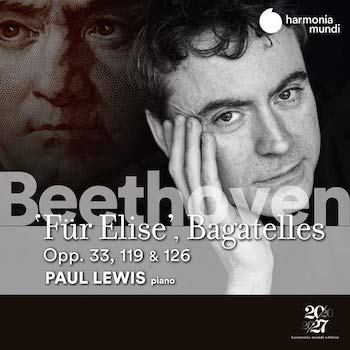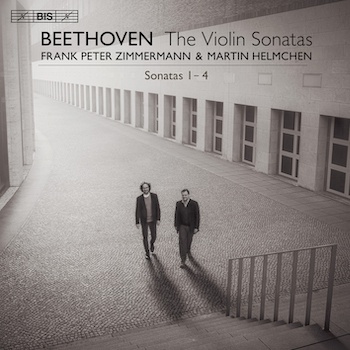Classical CD Reviews: Beethoven Chamber Music, Part 1 – Goerne & Lisiecki Lieder, Paul Lewis plays the Bagatelles, and Frank Peter Zimmermann plays Violin Sonatas
By Jonathan Blumhofer
Beethoven chamber music done right: a standout recital by two of the finest (and best-matched) artists of the day, Matthias Goerne and Jan Lisiecki; pianist Paul Lewis serves up one of the freshest releases of this Beethoven anniversary year, and Frank Peter Zimmermann delivers natural, completely unpretentious performances of four Beethoven violin sonatas.

There aren’t many genres Beethoven didn’t dominate, but song is one of them. Not that he wasn’t a prolific writer for the voice: in his catalogue, there are dozens of folk song arrangements, choral works, and pieces for voice and orchestra (or piano). However, few of them have stuck in the repertoire. That makes the present survey of the composer’s lieder by Matthias Goerne and Jan Lisiecki more than welcome.
Perhaps the most striking thing about the pair’s selections (which span much of Beethoven’s career) is the consistent brilliance of Beethoven’s keyboard writing in them. The vocal lines run from the essentially banal (as in 1790’s “Klage” or the devotional 1802 Sechs Lieder) to more through-composed and involved efforts (1796’s “Adelaide” and 1816’s An die ferne Geliebte). However, the keyboard “accompaniments” are constantly busy, sometimes downright virtuosic. It can add up to a challenging (and somewhat odd) imbalance between the parts. Yet there’s no sense of inequality in this set: rather, there’s a striking electricity between Goerne’s singing and Lisiecki’s playing.
Goerne brings compelling warmth to the proceedings, particularly in the Sechs Lieder and An die ferne Geliebte, which frame the album. At the same time, there’s a lightness to his voice that’s thoroughly winning, especially on the turn figures in Beethoven’s 1805 setting of Christian August Tiedge’s “An die Hoffnung” and in the high-tessitura episodes of “Adelaide.”
Throughout, Lisiecki’s pianism is invigorating: full of color, biting rhythmic energy, impeccable balances, and a wonderful command of the phrase. His playing in the chromatic 1815 version of “An die Hoffnung” is tightly focused, as is his account of the stormy keyboard writing in 1809’s “Der Liebende.”
The contrasts of Beethoven’s larger style come across with plenty of vigor here, too, be they the big shifts of intensity and dynamics in “Resignation” (from 1817) or the sheer charm of his setting of Goethe’s “Maigesang.” Indeed, there’s much that’s simply beguiling about these performances, from the dancing, Schubert-like “Lied aus der Ferne” to the utterly enchanting “An die Geliebte.”
Perhaps finest of all is “Das Liedchen von der Ruhe,” which gets a reading whose impassioned tonal focus really draws you in – especially across the quiet middle verses: a standout track in a standout recital by two of the finest (and best-matched) artists of the day.
 Beethoven’s piano sonatas may form the core of Western keyboard literature, but his three sets of Bagatelles remain somewhere on the fringes. Leave it to Paul Lewis, whose rerelease of the complete Beethoven sonatas and concertos provided one of the early highlights of this sestercentennial year, to prove the perfect curator for these terrific, idiosyncratic gems.
Beethoven’s piano sonatas may form the core of Western keyboard literature, but his three sets of Bagatelles remain somewhere on the fringes. Leave it to Paul Lewis, whose rerelease of the complete Beethoven sonatas and concertos provided one of the early highlights of this sestercentennial year, to prove the perfect curator for these terrific, idiosyncratic gems.
In the op. 33 set, Lewis plays up the music’s spastic unpredictability with knowing panache. The first is perfectly free and whimsical, its embellishments, sudden harmonic turns, and continuous variations coming across, in Lewis’s hands, with incredible rhythmic and textural clarity. That approach continues through the remaining six movements of the set, with their anticipations of later works (something shadowing the Fifth Symphony’s scherzo crops up in the middle of no. 4 and lots of Waldstein Sonata hints are apparent in the concluding no. 7).
The op. 119 set is highlighted by a sweetly delicate account of the song-like no. 4 and a taut, snapping take on no. 5. Throughout, Lewis’s playing is cleanly articulated and beautifully voiced, nowhere more so than over the second half of the radiant no. 11.
Much the same can be said for the six movements of op. 126. The toccata-like no. 2 features pristine balances between the hands, while Lewis crafts a dreamy atmosphere for no. 3. He also revels in the music’s play of contrasts, be that the mix of straightforward and improvisatory-like writing in no. 1 or no. 6’s wild juxtapositions of mood.
Completing the album are some smaller pieces and the brazenly weird G-minor Fantasia (op. 77).
In the former, Lewis’s take on the popular Für Elise is elegant and nicely shaped, as is his handling of the three Klavierstücke (in, respectively, B-flat major, B minor, and G minor).
The Fantasia is one of Beethoven’s strangest pieces, full of fitful jump cuts between seemingly unrelated musical ideas. Yet it’s a piece that’s also full of personality and character. With Lewis at the helm, it loses none of its strangeness, though his performance is, ultimately, coherent, personable, and carefully-voiced.
Overall, then, here is one of the freshest releases of this Beethoven anniversary year. This is music that, by and large, sounds like it’s almost straight from the sketchbook: improvisatory, rhapsodic in mood and approach to form. Lewis’s incisive playing captures all of its spontaneity yet there’s, retrospectively at least, always a clear sense of where things should be headed. Don’t miss it.
 There’s much to admire in this new recording of the first four Beethoven violin sonatas featuring violinist Frank Peter Zimmermann and pianist Martin Helmchen. Their readings are, as a rule, well-directed. Plenty of character is to be had in each. And both musicians exhibit lively rapport with one another.
There’s much to admire in this new recording of the first four Beethoven violin sonatas featuring violinist Frank Peter Zimmermann and pianist Martin Helmchen. Their readings are, as a rule, well-directed. Plenty of character is to be had in each. And both musicians exhibit lively rapport with one another.
That’s not to say that their approaches are identically matched. Zimmermann’s got a tendency to push or pull at the line here and there. Helmchen’s a bit stricter, rhythmically. But, taken together, the pair light some lovely sparks.
In the Sonata no. 1, textural clarity is the name of the game, especially in the first movement’s exchange of lines. The variations in the second are likewise lean, and the runs in the finale (from both instruments) sound downright exuberant.
Likewise, the A-major Sonata no. 2 draws playing of rhythmic vigor in its outer movements: the finale’s triplet arpeggios, in particular, sparkle. Zimmermann and Helmchen also engage in a sharply-etched dialogue in the minore second movement.
The Sonata no. 3 is similarly crisp and vigorous. There’s a lively play between the first movement’s duple and triplet rhythms, a lovely account of the central Adagio, and a spunky take on the brilliant finale, among other things. Throughout, everything’s articulated with great precision, both within and between the parts.
Much the same can be said of the duo’s account of the A-minor Fourth Sonata. Here, the music’s darker tonality and mood result in a performance of blustery turbulence throughout the opening movement. The second – both in terms of affect and performance – is fresh and compelling, while the contrasts between the finale’s driven and lyrical sections proves gripping.
Bis’s engineering is typically fine, even as Zimmermann’s fiddle is sometimes pushed just a bit forward in the mix (as happens in the opening movement of the Sonata no. 1). But that’s no big deal: these are natural, completely unpretentious performances, brilliantly felt and executed, and they do full justice to these scores.
Jonathan Blumhofer is a composer and violist who has been active in the greater Boston area since 2004. His music has received numerous awards and been performed by various ensembles, including the American Composers Orchestra, Kiev Philharmonic, Camerata Chicago, Xanthos Ensemble, and Juventas New Music Group. Since receiving his doctorate from Boston University in 2010, Jon has taught at Clark University, Worcester Polytechnic Institute, and online for the University of Phoenix, in addition to writing music criticism for the Worcester Telegram & Gazette.
